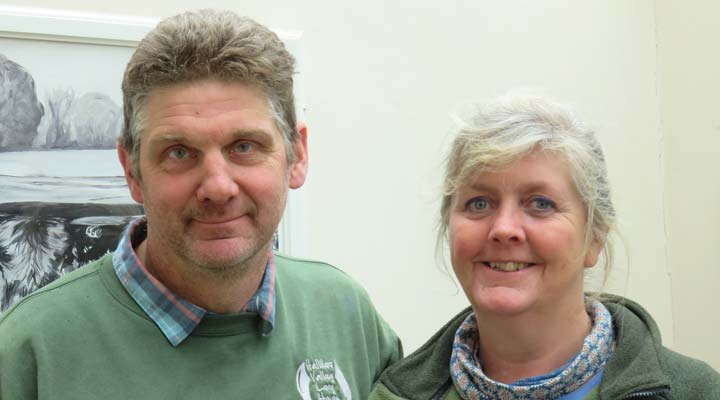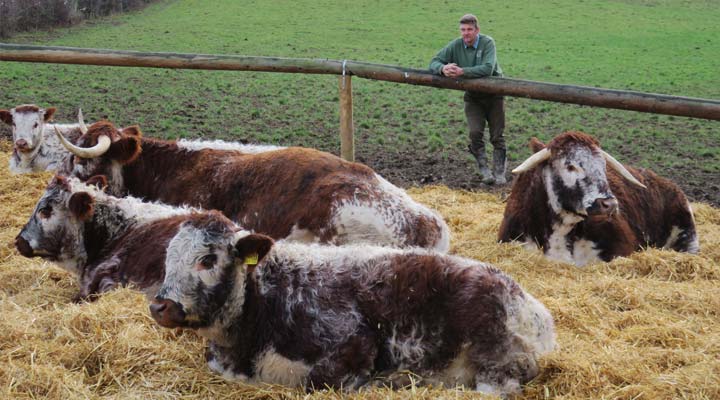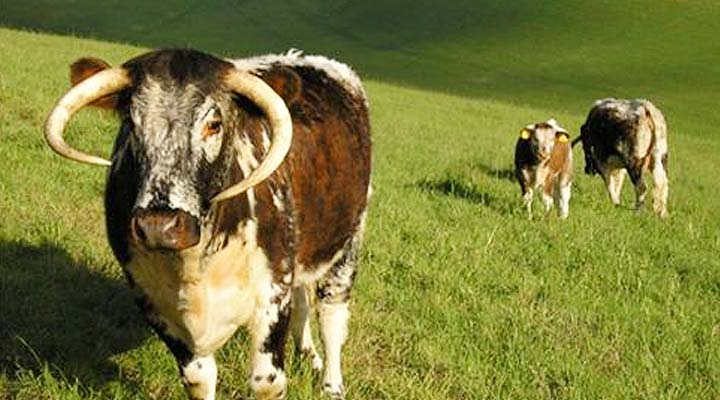Pasture for Life – Case Study – Halliloo Longhorns

Nick, Barbara and son Oliver Fuller have been building their herd of Halliloo Longhorn suckler beef cows since 2007. Starting with one old cow and two heifers, they now have 31 cows and six bulling heifers.
The herd is one third of Church Farm Services, alongside a flourishing contracting business making 2,000 bales of haylage, 4,500 bales of hay and 200 big bales of lucerne haylage every year, and two livery yards hosting 72 horses.
Oliver is the sixth generation of Fullers to farm in Woldingham originally at Halliloo Farm. They are tenants of the 163ha Warren Barn Farm and 12ha at Church Farm. A further 230ha is rented from 18 different landlords – small parcels of land surrounding large houses typical of the area on the North Downs in Surrey, within the M25 but seemingly miles away from the Capital.
“Back in the day, our family were market gardeners and dairy farmers selling into Covent Garden with a milk round in Purley,” explains Nick Fuller. “We gave up the bottle round when pasteurization came in and gave up the cows and growing crops all together at the end of the 1980s. We grew crops and started the contracting business fencing and making hay. But the cows came back!”
The Fullers chose Longhorn cattle after seeing some at the Oxted and Edenbridge Show. They are easy to look after, calve unaided and are good mothers with plenty of milk and are docile. In ten years, the vet has been called in just twice.

The cows calve all year round to give continuity of supply of meat and the bull lives out with the herd full time. The cattle graze the steep slopes and valleys of the North Downs during the summer and out-winter on unfenced chalk pads in the corner of one or two free-draining fields. Straw is spread out across part of the chalk pad for the animals to lie on.
The cows are also given grass and lucerne haylage in round feeders and the calves have access to a covered area where they can eat their own lucerne haylage. No concentrates or grain feeds are ever offered.
Two groups of youngstock, which are weaned at eight to nine months of age, graze the small parcels of land in summer and live on chalk pads similar to the cows and calves in winter.
Beef marketing
Two beasts aged up to 30 months, are slaughtered every month at a small abattoir just seven miles away. They weigh between 300 and 310kg deadweight.
One carcase is sent whole to butcher Nathan Mills at The Butchery in South East London, where the focus is on native breeds, small farmers and a nose to tail philosophy. The other carcase is cut down and returned butchered to order to the Fullers.
Barbara has a clean and up-to-date email list and tells her customers what is coming up for sale at their pop-up shop in the farmyard on a forthcoming weekend.
“Our carcases are hung for a full 28 days – which means we lose 20% of the weight, but makes sure we derive the best possible flavour,” says Barbara.
“Longhorns develop marbling within their meat without laying down excessive fat. Marbling is a reliable indicator of good flavour and a succulent and tender piece of meat.
“We are also keen on educating our customers that there are pieces of exceptional tasting cuts other than fillet or rib. We find that many people are afraid of what they don’t know, but we are now getting more people asking for things like brisket and braising steak.
“We also work with pie makers from Southsea who make 750 gluten-free pies a year with our 100% grass-fed meat in them. We also promote our beef as much as we can through our Facebook pages.”

Pasture for Life
The Fullers have been members of the Pasture-Fed Livestock Association for six years after seeing general manager Russ Carrington talking to John Craven about Pasture for Life on Countryfile.
“With our system it is very easy to become a member and to become certified,” says Barbara. “We are very proud of our certification and I am delighted to say we sailed through our audit just before Christmas.
“The Certification mark, the Pasture for Life rosette, is really important for us – it is a sign of integrity and trust. Our customers know that the meat they buy comes from animals that were 100% grass-fed.
“Everything works in harmony. The breed of cow suits our landscape and the cattle are easy to care for. They are healthy and grow slowly on just grass and conserved grass and lucerne, so are relatively cheap to feed compared to animals finished on grains.
“Our beef enterprise has developed slowly over the years but has reached a point where customers come back time and again. We see a great future for our Longhorn cattle.”



